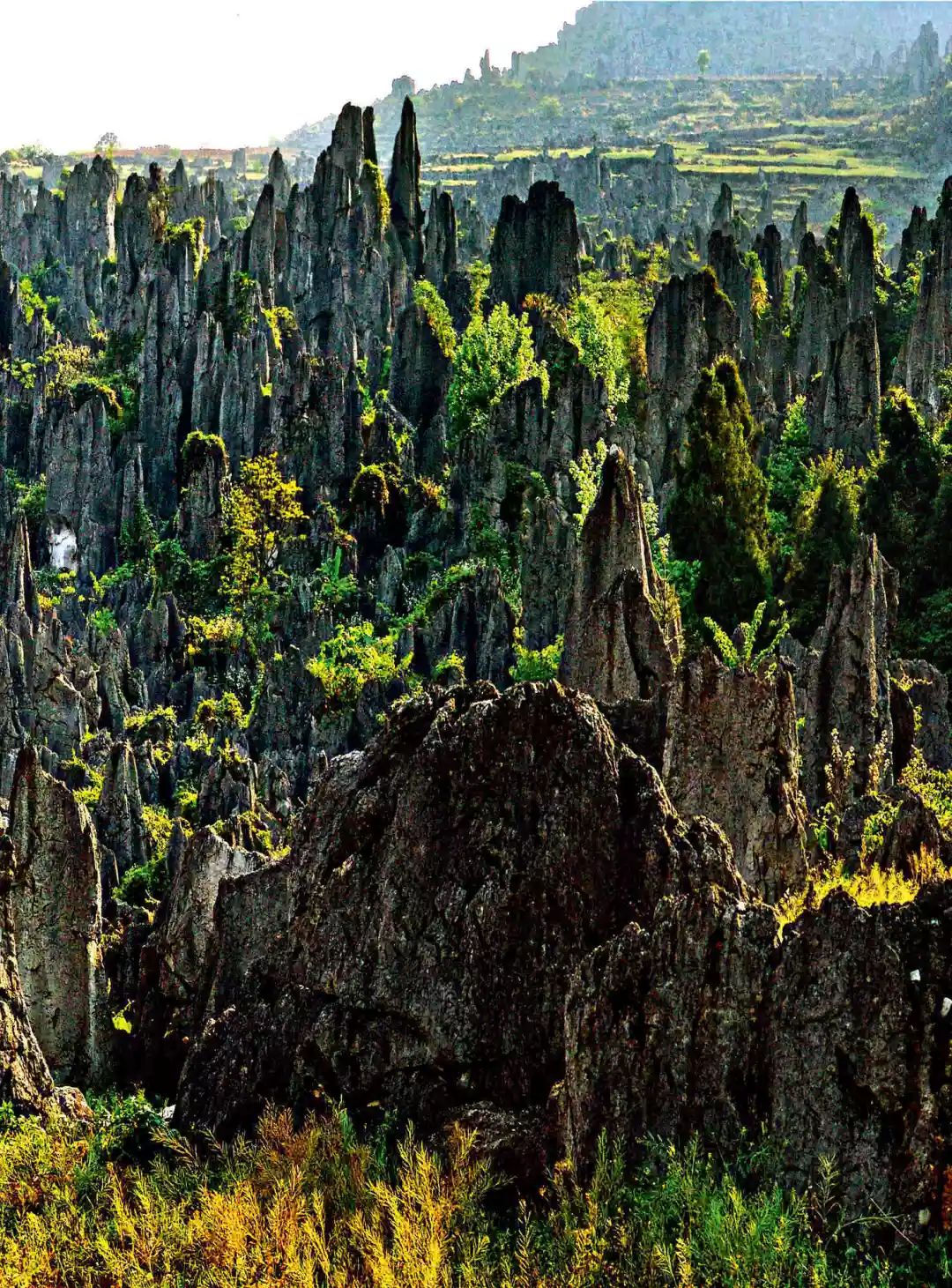-This article is reproduced from the public account: China National Human Geography-

As two karst pearls on the Yunnan-Guizhou Plateau, the Nidang Stone Forest in Xingyi, Guizhou and the Lunan Stone Forest in Yunnan have their own characteristics. If Lunan Stone Forest is a lady of every family, then Nidang Stone Forest is Xiaojiabiyu. The stone peaks in the Lunan Stone Forest are tall and powerful, rippling away, while the Nidang Stone Forest is a thin-slice stone tooth forest with many holes, rich and vivid shapes, magical and beautiful.
The Stone Forest is located in Nidang Town in the south of Xingyi City, hence the name “Nitang Stone Forest”. It is a provincial scenic spot in Guizhou. Nidang Stone Forest Scenic Area is 4 kilometers long from east to west, 2 kilometers wide from north to south, with a total area of more than 200 hectares.
The Nidang Stone Forest is formed in the junction zone of the northeast-southwest main fault and branch faults. The terrain is rugged and there are many mountains. The rock formations are cut into “checkerboard formations”. It is these factors such as lithology, structure and dissolution that control the formation and development of stone forests.
According to research by geologists, about 280 million years ago, the area around the Yunnan-Guizhou Plateau was a vast ocean. Many animals and plants grew in the seawater of the Nidang Stone Forest and on the nearby land. Due to the hot climate and abundant rainfall, animals and plants grow and die quickly. Their carcasses are deposited on the seabed, forming a thick sedimentary layer. After hundreds of millions of years of geological processes, thick carbonate sedimentary rocks are formed. .
About 70 million years ago, the Yanshan Movement that spread to the land of China occurred, and the seabed was gradually raised, and the rocks hidden on the seabed emerged from the water. The sea water beats the rocks constantly, and “bites” deep cracks on the rocks. Coupled with weathering and wind erosion, many cracks and pores appear on the rocks. After hundreds of thousands of years of scouring and dissolution by rainwater containing carbon dioxide and organic acids, many dissolution grooves were formed on the whole rock, and finally the whole rock mass was separated, forming stone buds, stone pillars, stone gates, and stone peaks. stone wonders.

Formation of Stone Forest
After the stone forest was formed, due to the small inclination angle, it rarely collapsed and fell to the ground, and was later covered and protected by late Tertiary red soil. About 2.5 million years ago, the Quaternary crust was uplifted, and the rain washed away the late Tertiary soil layer, revealing the stone forest again.

Stone Forest Charm
The Nidang Stone Forest is divided into two parts, the front and the back. The “Former Stone Forest” is located in the area of Fengbowan and Daijiaba. The stone peaks, stone pillars, and stone buds formed by limestone are scattered all over the place, which are either independent or intertwined. Some are in the shape of rare birds and beasts, leaping and galloping; some are in the shape of people with different postures;
The most special thing about Fengbowan Stone Forest is that you can climb up to the viewing platform of Longyin Tiankong Mountain and He Yingqin’s former residence, where you can enjoy the wonders of clouds, mountains and seas of mist and the beauty of sunset and sunrise. The building of He Yingqin’s former residence is composed of the court gate, the hatchback and the main hall. It has obvious architectural characteristics of folk houses in the late Qing Dynasty, and has high architectural art value and historical and cultural research value.
The Longjia Stone Forest connected with Daijiaba Stone Forest is called “Hou Stone Forest”. “Optimus Prime” soars into the sky, “Jianfeng Stone” is steep and sharp, “Gussao Stone” clings to each other, “Old Man Collecting Medicine” climbs on the cliff with a staff “Returning at Night”, the majestic “Warrior Peak”, “One General Guards the Pass”, “General Expedition”, etc., are all wonderful in shape. In addition, there are quite a few rock-like peaks, such as “Golden Monkey Watching the Moon”, “Camel Peak”, “Elephants Competing for Drinks”, “Tiger Cubs Playing with each other”, “Eagle Spreading Wings”, “Stone Bergamot”, “Mushroom Stone”, etc., all of which are vivid. There are also 6 stone peaks, unwilling to be lonely, joining hands to form the word “mountain and river”, which stands tall and majestic.

The stone dragon formed by the stalactites on the wall of Lijiawanzi Karst Cave is facing the Crouching Tiger Stone in Daijiaba. Here, there is a folk song: “Stone Dragon vs. Stone Tiger, gold and silver are 55,000, who can see through it, buy out Yunnan Mansion.” After the Nanming regime was wiped out one by one, the Qing Dynasty granted him the power to take charge of Yunnan’s military and civilian affairs, and later also governed Guizhou, so Wu Sangui established a mansion in Yunnan and became the local emperor who ruled Yunnan.
Wu Sangui transported all the gold, silver and jewels he looted to Nidang (called “Wutai Village” at the time) on the main road from Yunnan to Guangxi for burial in preparation for the future confrontation with the Qing Dynasty. Since all the civilian husbands in charge of hiding the gold were killed, and the officers and soldiers in charge of the aftermath were also missing, Wu Sangui’s treasure is still a mystery. There is also a folk proverb that “a melon grows in Yunnan, and yellow flowers bloom at the bottom of Wusha River. The branches and leaves of Wanfeng in Maling are luxuriant, and the last Wutai bears melons”. of a beautiful story.
· END ·




